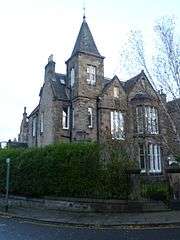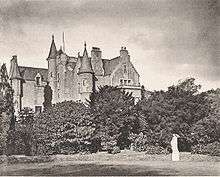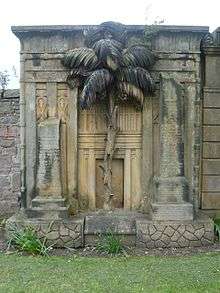The Grange, Edinburgh

The Grange (originally St Giles' Grange) is a suburb of Edinburgh, about one and a half miles south of the city centre, with Morningside and Greenhill to the west, Newington to the east, and Marchmont to the north. It is a conservation area characterised by large late Victorian stone-built villas, often with very large gardens. Many have now been sub-divided into flats, with further flats often being built on the grounds.
Superiors
There are mentions of 'Sanct-Geill-Grange' in charters of King David and King Edgar, as church lands attached to St. Giles parish church in Edinburgh, the king retaining the superiority.[1] The word grange is common across Britain and normally links to an extensive farm with a central mansionhouse (corrupting to the word range in America). On June 16, 1376, King Robert II granted the superiority of the barony and lands of St Giles to his eldest son, John, Earl of Carrick, Steward of Scotland.[2] In 1391 the estate was conferred upon the Wardlaw family.[3]
On October 29, 1506, St Giles Grange passed to John Cant, a Burgess of Edinburgh, and his spouse Agnes Carkettle,[4] and in 1517 they granted the use of 18 acres (73,000 m2) of land to the nuns of St. Catherine of Siena.[5] On March 19, 1691 a John Cant sold St Giles Grange in its entirety to William Dick. It is interesting to note that at that time the 18 acres (73,000 m2) previously feued to the nuns was now in the possession of Sir John Napier, the famous inventor of logarithms.[6] When Isabel Dick, the heiress, married Sir Andrew Lauder, 5th Baronet of Fountainhall, in 1731, The Grange passed to him.
Grange House

The original tower house appears to be of a very early date possibly the 13th century, ornamented with two turrets and a battlemented roof; its position was isolated at the eastern end of the Burgh Muir, which at that time consisted of waste tracts of moorland and morass, stretching out southward as far as the Braid Hills and eastward to St. Leonard's Crags.[7]
The mansion, The Grange House, was enlarged over the centuries, a major restoration being carried out by Sir Thomas Dick Lauder, Bt.[8] On May 16, 1836, Lord Cockburn recorded in his diary: "There was an annular eclipse of the sun yesterday afternoon....it was a beautiful spectacle......I was on the top of the tower at The Grange House, with Sir Thomas Dick Lauder and his family."
The house survived until 1936 when it was demolished to make way for flats. Stone wyverns from its gateposts, known locally as the 'Lauder griffins', were re-erected in Grange Loan. One was placed at the entrance to a stretch of Lover's Loan, a centuries-old path which was preserved in a late 19th-century redevelopment and is marked out with high stone walls separating it from the gardens on either side. At one point the path borders the Grange Cemetery where various well-known people are buried, including Sir Thomas Dick Lauder, Hugh Miller, and Thomas Chalmers.
City arrives
In 1825 Thomas Dick Lauder the then owner of the Grange, sold off a large area of land for development (mow the area between Dick Place and Grange Road. This linked to a new access road to the east (now called Newington Road). Lauder controlled development of the land through a strong feuing plan and developments required his approval. The original feuing plan included curious plot names such as Little Transylvania and Greater Transylvania (both north of Grange Loan). Grange House remained in a large plot in the centre of Grange Loan.[9]
From the 1840s The Grange was developed as an early suburb, built gradually upon the lands of The Grange estate — still owned by the Dick Lauder family. The area was originally laid out by the architect David Cousin but then the feuing was altered (1858) and greatly extended southwards (1877, following great success) by the architect Robert Reid Raeburn.[10]
Some of the Victorian villas still retain substantial mature trees and gardens which pre-date the housing. In 1835 Earl Grey (of Reform Bill fame) stayed with Sir Thomas Dick Lauder at The Grange House, and commemorated his visit by planting an oak-tree in a conspicuous spot in The Avenue, upon the bank of the north side, not very far from the ivy-clad arch. It was called 'Earl Grey's Oak' and was still healthy in 1898.[11] It is not known if it has survived.
Within the area lies the campus of the Astley Ainslie Hospital. This large area of ground was gifted as a hospital in 1921 as part of the will of John Ainslie.[12]
The Grange Cricket Ground is the last vestige of the major open space which used to surround Grange House.
Grange Cemetery


This was laid out in 1847 by the Edinburgh architect David Bryce and is more rectilinear in layout than its predecessors, Warriston Cemetery and Dean Cemetery. It was original entitled the Southern Edinburgh Cemetery.[13]
It includes a very interesting "Egyptian portal" to the land of the dead for the wife of a William Stuart (died 1868) on the north wall, by the sculptor Robert Thomson. Sculptures by William Birnie Rhind (Dr. James Cappie) and Henry Snell Gamley (David Menzies) can also be found. There are also multiple ornate Celtic crosses, mainly by Stewart McGlashan. Other notable graves include:
- John Brown Abercromby (1843-1929), artist
- Harry Burrows Acton (1908-1974)
- Prof David Laird Adams
- Sir Andrew Agnew, 7th Baronet
- Rev William Arnot
- Rev David Arnott DD
- Sir William James and Sir James Gardiner Baird, 7th and 8th Baronets of Saughton Hall
- Very Rev John Baillie, Moderator of the General Assembly of the Church of Scotland, 1943/44
- Sir Andrew Balfour, physician (grave vandalised)
- James Bannerman (theologian)
- John Bartholomew, Sr. and John Bartholomew Jr. mapmakers
- John Begg (architect)
- Henry McGrady Bell (1880-1958) traveller, diplomat and author
- Sir Robert Duncan Bell (1878-1935) senior civil servant in the Indian Raj
- George Bertram, engineer and paper-maker
- Benjamin Blyth (engineer)
- Robert Henry Bow FRSE (1827-1909) photographic pioneer and civil engineer
- Hugh Wylie Brown FRSE, actuary
- Rev John Brown, Moderator of the Church of Scotland 1916 (his memorial also marks 4 sons lost in WWI)
- George Washington Browne (architect)
- Viscount Bryce politician
- James Bryce (geologist) plus his son John Annan Bryce, MP for Inverness
- Rev James Buchanan
- Rev Dr Thomas Burns (1853-1938) founder of the Thomas Burns Homes
- Sir John Alexander Calder
- Edward Calvert (architect)
- Hugh Cameron RSA (1835-1918) artist
- James Roderick Johnston Cameron, author, President of the Royal College of Surgeons of Edinburgh
- Dr John Henry Campbell, monument by John Hutchison RSA
- John Irvine Carswell FRSE engineer
- Dr Thomas Chalmers
- Dugald Christie (missionary)
- Rev Prof G. N. M. Collins twice Moderator of the General Assembly of the Free Church of Scotland
- Robin Cook
- Prof W. M. Court-Brown (1918-1968) radiologist and medical author
- Alexander Cowan papermaker and philanthropist, with his son James, Lord Provost of Edinburgh and MP for Edinburgh
- Sir Robert Cranston
- Rear Admiral Octavius Cumberland (1813-1877)
- Rev Prof William Cunningham
- Walter Scott Dalgleish (1834-1897) author
- Prof Andrew B. Davidson
- Lt Col Lewis Merson Davies geologist and anti-evolutionist
- The Dick Lauder baronets
- William Kirk Dickson and his son, Rear Admiral Robert Krk Dickson
- Alexander Graham Donald FRSE FSA FFA
- Greta Douglas (1891-1982) artist
- Morrell Draper FRSE, Australian born toxicologist
- Rev Alexander Duff (missionary)
- Rev Prof John Duncan (theologian)
- Rev Patrick Fairbairn
- Prof Robert McNair Ferguson LLD (1829-1912) mathematician
- Rev Thomas Finlayson
- Rev William Galbraith (mathematician)
- Rev James Gall astronomer and founder of Carrubbers Close Mission.
- William Galloway (architect) (1830-1897) early conservation architect and historian
- Dr Jessie Gellatly MD one of Britain's first female doctors[14]
- Archibald H. R. Goldie, FRSE, meteorologist
- Giles Alexander Esme Gordon
- Sir James Gowans
- General James Hope Grant
- Alan William Greenwood FRSE, zoologist
- David Grieve FRSE PRPSE, geologist
- John William Gulland MP and his nephew, John Masson Gulland FRS FRSE, chemist
- William Maxwell Gunn LLD (1795-1851) author
- Dr Thomas Guthrie
- Robert Halliday Gunning surgeon and philanthropist
- Henry Haig (engraver) (1795-1848)
- Rev William Hanna (1808-1882)
- Canon Edward Joseph Hannan, co-founder of Hibernian Football Club
- Admiral John Hay (1804-1899)
- John Henderson (architect) (1804-1862)
- Prof William Henderson (physician and homeopath)
- Robert Herdman RSA, Victorian artist
- Rev William Maxwell Hetherington (stone carved by John Rhind)
- William Ballantyne Hodgson
- William Hole (artist)... (buried in the ground of James Lindsay WS)
- The Home baronets, John (1872-1938, 12th Baronet of Blackadder) and David George (1904–1992, 13th Baronet of Blackadder)
- John Hutchison (sculptor)
- David Irving (librarian)
- Alexander Keith Johnston (1804–1871) geographer (also memorialising his son of the same name, an African explorer).
- Christian Isobel Johnstone author, journalist and feminist
- Prof Arthur Berriedale Keith
- David Kennedy (1825–1886) Scottish singer (subject of a monument at the foot of Calton Hill) plus his daughter Marjory Kennedy-Fraser
- John Kinross (architect)
- Thomas Dick Lauder, author and landowner
- Prof Simon Somerville Laurie, educator
- Robert Lawson (physician) FRSE (1846-1896)
- Rev Prof Robert Lee DD FRSE theologian (sculpted by John Hutchison)
- William Lennie (grammarian) (1779-1852)
- Rev Mary Levison DD (born Mary Irene Lusk), first ordained female minister in the Church of Scotland
- Prof David Liston
- David Fowler Lowe FRSE LLD (1843-1924, Headmaster of George Heriot's School
- Major General William McBean VC (1818-1878) winner of the Victoria Cross at the Siege of Lucknow
- Sir George McCrae (politician) (1860-1928)
- Very Rev William J. G.McDonald (1924-2015) Moderator of the General Assembly of the Church of Scotland in 1989, presenter on radio's Thought for the Day
- Very Rev James MacGregor DD (1834-1910) Moderator of the General Assembly of the Church of Scotland 1891
- Very Rev Mackintosh MacKay (1793-1873) Moderator of the General Assembly of the Free Church of Scotland in 1849 (memorial only - buried in Duddingston Kirkyard)
- Paul MacKenzie (physician) (1919-2015) soldier and sportsman
- James MacKillop, MP
- Meta Maclean, author
- Charles Maclaren, founder and editor of the Scotsman newspaper
- Hector C. Macpherson FRSE author and journalist
- Sir Alexander Charles Gibson Maitland
- Charles Alexander Malcolm, historian and author
- Rev Prof William Manson theologian
- David Masson historian
- David Mekie and his son, Prof David Mekie OBE FRSE surgeon
- Memorial to Wiliam Babington Melville, killed in the Manipur Massacre of 1891
- Duncan Menzies (1837-1910) architect and engineer
- Hugh Miller (pioneer geologist)
- Prof James Miller FRSE (1812-1864)
- Rev Dr William Milligan (1821-1893)
- Sir Henry Moncrieff, 2nd Baron Moncrieff with a sculpture of his wife "Minna" on the stone
- Robert Morham (architect)
- John Muir (indologist)
- Sir Andrew Mure (1826-1909) judge
- Duncan Napier (herbalist)
- James Napier (chemist)
- Thomas Nelson (publisher)
- John Pringle Nichol (astronomer)
- Rev Dr Maxwell Nicholson DD, author, minister of both Tron Kirk and then St Stephens
- Prof James Nicol geologist
- Very Rev Robert Nicol, Moderator of the Church of Scotland 1914
- Very Rev Prof Thomas Nicol DD, theological author, Moderator of the General Assembly of the Church of Scotland 1914
- Frederick Niecks musical scholar
- John Nisbet, artist (with his 3 wives)
- Pollock Sinclair Nisbet, artist
- Robert Buchan Nisbet, artist
- Rev Prof John Cochrane O'Neill (1930-2003) theological author
- Thomas Oliver, co-founder of Oliver & Boyd
- George Ann Panton (1842-1903) and his namesake nephew (1857-1934) both Fellows of the Royal Society of Edinburgh
- Sir Edward Parrott politician
- Waller Hugh Paton RSA, artist
- Very Rev David Paul DD LLD FLS, Moderator of the General Assembly of the Church of Scotland in 1915
- Very Rev Adam Philip Moderator of the General Assembly of the United Free Church of Scotland in 1921.
- Sir Robert William Philip, pioneer of tuberculosis
- James Ramage (artist) (1824-1887)
- James Reed FRSE engineer
- Very Rev George T. H. Reid MC DD (1910-1990) Moderator of the General Assembly of the Church of Scotland in 1973
- Rev Prof Alexander MacDonald Renwick DD, theological author
- John Thomas Rochead, architect of the Wallace Monument
- Sir Hugh Arthur Rose and his son, Sir Hugh Rose
- Frederick Schenck, lithographer
- Dr Robert Edmund Scoresby-Jackson FRSE physician and biographer
- Sir Thomas Drummond Shiels MP
- Prof James Young Simpson (scientist) and his father Sir Alexander Russell Simpson
- Dr David Skae (1814-1873) phsychiatrist
- Sir William Lowrie Sleigh, Lord Provost of Edinburgh 1923-6
- Prof George Smeaton
- George Smith RSA (1870-1934) artist
- The sculptor brothers David Watson Stevenson and William Grant Stevenson buried together
- Rev William King Tweedie DD (1803-1864) religious author and his son, Major General William Tweedie of the Sepoy mutiny
- James Thin (1824-1915) founder of a renowned Edinburgh bookshop
- Surgeon Major General Peter Stephenson Turnbull (1836-1921)
- Andrew Usher
- Sir John Usher, Baronet
- Cecil Voge FRSE (1898-1978) chemist
- Sir George Warrender of Lochend, 6th Baronet (after whom the Warrender section of Marchmont is named)
- George Mackie Watson (1860-1948) architect
- Rev Robert Boog Watson (1823-1910), scientist
- David Monro Westland, architect/engineer (creator of the North Bridge)
- Prof Charles Richard Whittaker FRSE (1879-1967) anatomist
- Harry Martin Willsher, author
- Robert Wilson architect of the Edinburgh Board Schools[15]
- Sir James Lawton Wingate (artist)
- Sir Alexander Kemp Wright, banker
- Robert Stodart Wyld LLD (1808-1893) historian
- Robert Young (biblical scholar)
There are war graves of 40 Commonwealth service personnel of both World Wars[16] and a communal grave for the nuns of St Margaret's Convent.
In popular culture
Residents of the suburb have included the author J.K. Rowling[17][18] and the former CEO of RBS, Fred Goodwin.[19][20] Goodwin relocated from The Grange after the vandalism to which his property there was subjected[21] but has since returned after his wife's throwing him out of their family home in Colinton due to revelations of his marital infidelity.[22]
The Grange was also a principal filming location during the production of the BBC Three comedy-drama Pramface which starred Scarlett Alice Johnson and Sean Michael Verey in the lead roles. The Grange features extensively in the showpiece but is appropriated in order to pose as an upmarket North London suburb due to its appearance similarities for the sake of plot integration.[23]
Notes
- ↑ Stewart-Smith, J., The Grange of St. Giles, Edinburgh, 1898: 2
- ↑ The Great Seal of Scotland, 1306-1424: 27
- ↑ The Great Seal of Scotland, 1306-1424: 40
- ↑ The Great Seal of Scotland, 1424-1513: 2999
- ↑ Stewart-Smith, J., The Grange of St. Giles, Edinburgh, 1898: 21
- ↑ Stewart-Smith, J., The Grange of St. Giles, Edinburgh, 1898: 28-9
- ↑ Stewart-Smith, J., The Grange of St. Giles, Edinburgh, 1898: 5
- ↑ Stewart-Smith, J., The Grange of St. Giles, Edinburgh, 1898: 328-336
- ↑ Grange Conservation Area Character Appraisal: City of Edinburgh Council
- ↑ Buildings of Scotland: Edinburgh, by Gifford McWilliam and Walker
- ↑ Stewart-Smith, J., The Grange of St. Giles, Edinburgh, 1898: 340
- ↑ Grange Conservation Area Character Appraisal: City of Edinburgh Council
- ↑ http://maps.nls.uk/view/102190564
- ↑ "Dr. Jessie H. Gellatly". Br Med J. 2: 188. 1935. PMC 2460619
 . PMID 20779254. doi:10.1136/bmj.2.3890.188-a.
. PMID 20779254. doi:10.1136/bmj.2.3890.188-a. - ↑ Dictionary of Scottish Architects: Robert Wilson
- ↑ CWGC Cemetery Report.
- ↑ Coulters Property Sales and Lettings - Edinburgh Neighbourhood Spotlight: The Grange
- ↑ The Damnation of Fred Goodwin
- ↑ The Damnation of Fred Goodwin
- ↑ Fred the Shred is back: Shamed RBS boss returns to country he nearly bankrupted after buying £3.5m 'WAG dream house'
- ↑ The Guardian - Vandals target Sir Fred Goodwin's house and car
- ↑ The Scotsman - Wife kicks cheating Sir Fred out of family home
- ↑ The Scotsman - Edinburgh to be backdrop for new BBC comedy series
References
- Stewart-Smith, J; The Grange of St Giles, Edinburgh, 1898, is possibly the best history of The Grange extant.
External links
- Bartholomew's Chronological map of Edinburgh (1919)
- Grange Association
- Edinburgh University Gazetteer article on The Grange
Coordinates: 55°56′6.82″N 3°11′15.28″W / 55.9352278°N 3.1875778°W
